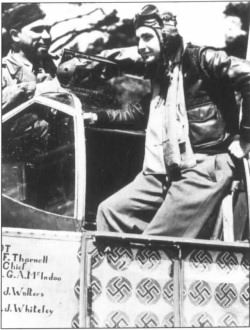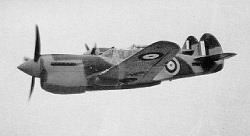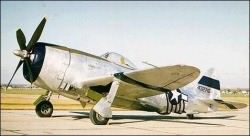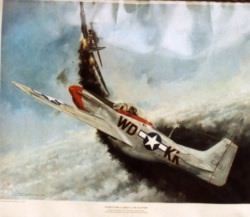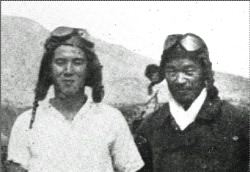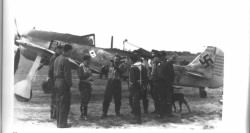|
Gun Kills by Jim "Twitch" Tittle |
||||
|
"There was a tremendous urge to drop your nose and eyeball the guy but instinct takes over and you shoot him without seeing him." That's what Jack Thornell said about firing in a turn when the nose of your plane is leading the enemy and actually blocks him from view. Thornell flew the P-51B for all his 17.25 victories even when the six gunned "D" became available. He didn't mind that the "B" had only four .50 calibers. He had a shooter's eye which compensated for the firepower. He was good enough to make triples on two occasions with the 1,260 rounds his Mustang carried. REAL OR SIMULATED? I finally got a question answered that I'd pondered over a long time while simulator flying. How accurate to reality was the above scenario I'd encountered in sims? It was right on the mark! You get into the flow and feel it. I always felt that occurrence was tantamount to Yoda and Luke Skywalker discussing "the force."
At the 1998 convention of the American Fighter Aces Association I asked Jack Bradley, 15 victory ace who scored kills from "all distances," the same question and he replied, "You can drop your nose and look if you're far enough away since you can easily point in the lead to compensate again." 30 to 45 degrees was a comfortable angle to fire at another aircraft whether on the horizontal axis or the vertical one. 30-45 degrees above or below and from 30-45 degrees to the side was an ideal angle I'm told. But pilots preferred to attack from six o'clock even though the target is smaller. Again, I've found the 30-45 degree angle to be superb for sim kills. I am less deadly from the six level position but a bit better from six low or high. Flying Tiger Tex Hill favored the six o'clock high pass on the Japanese planes he fought with the P-40. It worked well enough for 18 3/4 victories.
Wiltz "Flash" Segura recalled his six victories in the P-40 relating how "you could hold the trigger for a split second at a time only since we didn't have that much ammo." The P-40 carried only 281 r.p.g. Good advice for simulator pilots too. Head on attacks were another favorite of American pilots against Japanese aircraft. Ralph Wandrey was one of Dick Bong's favorite P-38 wingmen. He describes the third victory of his six like this. "This was my 3rd confirmed kill made Oct. 17, 1943, just offshore of Buna, New Guinea. The fight was over the ocean and only a few scattered clouds above. The enemy planes were Navy camo (flying out of Rabaul) and the Zero came at me head-on from slightly above. My cannon shells exploded on his nose and shattered the cockpit canopy. He smoked and as I pulled up he passed directly below me. He was in flames by then, and the pilot was slumped in his seat with flames on both sides of the cockpit. I circled left and he had crashed into the ocean leaving a column of black smoke. The action took place at an altitude of around 3,000 feet." Wandrey flew the P-47 also. Like most guns mounted in wings, they were set to converge at 300 yards. Convergence was roughly a three foot square of destruction. Wandrey rarely fired at over 100 yards and sometimes it was less that 40. He simply used the four guns on one wing or the other at close range. He always aimed at the cockpit.
Wandrey had 10 probables when flying the P-47. "I was alone and snuck up on a group of Zeros flying in two rows line astern and closed to within 50 feet behind them. My guns were lined up on the canopies and I held the trigger down till I was out of ammo. The night before it had rained and it seems the gun camera film got wet. All it showed was dark and light flashes." Without confirmation no kills could be awarded. It was very rare for a pilot not to use tracer ammunition. Though highly corrosive, the tracer gave an indication of the flight pattern of the rest of the ordnance. Even the masters like Bong and McGuire used them. Wandrey mentions that tracers tracked "like a sloppily thrown football." A YANK IN THE SPIT Jerry Collinsworth flew Spitfire Vs and IXs in Tunisia 1943 with the U.S.A.F. shooting down six Fw 190s. Here are some of his comments about gunnery. "In our time each squadron was allowed to harmonize their guns at any range the unit desired. The 307th harmonized at 150 yards as I recall. I believe the other two squadrons harmonized at different distances. We also didn't use "tracers" while the other two squadrons did. Or at least one did because I shot an aircraft down on one mission having to fly another squadron aircraft because we were out of airplanes. Both the Spit V and the Spit IX I flew had two 20 MMs and 4 .303's. The 303's were practically worthless against the armor plating of the 190's and the 109's. And the 20's only carried 60 rounds per gun on the V. I believe the 303's had about 300 rds. per gun." |
"I found the best approach was low and from the 8 to 4 o'clock position. Generally, when you first started hitting their aircraft they bailed out. But you took whatever position you were in when the event took place. There was not much time to change the situation to any great extent." AERIAL KARATE Saburo Sakai and his bunch had the distinct advantage of ultimate maneuverability. Many encounters with enemy planes were decided by their Zero's maneuverability. But the basics were still adhered to- making fast gunnery passes and breaking away whenever possible. With only 60 rounds per gun, the two 20mm's on the Zero were used only when hitting was a near certainty. Sakai found the head-on pass against the B-17 worked best as did the Luftwaffe later.
The tried and true blind spot attack worked for Sakai in May, 1942 over Moresby when he spotted a lone P-39. "I kept gaining altitude from directly beneath his belly, where the pilot was completely blind." Sakai narrowed the distance to twenty yards, noting the slow cruise of the Airacobra of 130 knots, until he was at a 4 o'clock low position. His wingmen bracketed the escape routes if the P- 39 tried to break. "He was a big man, wearing a white cap. I studied him for several seconds before dropping below his fighter. I aimed carefully before firing, then jabbed lightly for a moment on the cannon trigger. There was a cough and (I later discovered) two shells from each weapon burst out.. I saw two quick explosions along the bottom of the P-39's right wing and two others in the center of the fuselage. The P-39 broke in two! The pilot did not bail out." THE LUFTWAFFE WAY Gunther Rall, third ranking Luftwaffe ace with 275 victories, liked the 20 mm cannon in his Bf 109's. When I asked if it was adequate armament he replied, "Yeah, once you got him lined up it's boom, boom, boom and it's all over." Horst Petzschler, 26 victory ace, disliked the extra two 20mm's in the under-wing gondolas on the 109 models for the loss of performance they caused. "The four, two centimeters of the FW 190 were best, especially in ground attack." The 190's guns were inside the wings compared with the "gondolas" that housed the added 20mm's on the 109. Petzschler wistfully remembered the 190's ample armament in a comment to me a couple of weeks ago. With a wistful, far-away look in his eyes he remarked, "Ah, the 190 had 250 rounds per gun; a lot of ammo." Sounds just like something a sim enthusiast would say! Adolf Galland, credited with 104 victories, relates an incident during the Battle of Britain. " I dove down from above at high speed and fired at the far left aircraft in the rear flight, continuing to fire to point-blank range. Finally large pieces of metal flew off the Hurricane. As I shot past him I found myself in the middle of the enemy squadron. (I've done that before in sims!) I immediately attacked the right-hand aircraft leading a flight of three. Again metal panels tore off and the plane nosed over ablaze." 101 victory ace, Josef "Pips" Priller, relates a perfect attack in 1941. "I saw a lone Spitfire in a north-westerly direction over land (France) at 6,000 meters. I flew after it, approaching to twenty meters without being observed. Then I opened fire with all my weapons from behind and beneath it. The bottom of the fuselage started smoking; pieces then broke off the fuselage and wings. The plane pulled up, stalled, and fell away to the left. I saw the Spitfire hit the water. The pilot had not bailed out." In simulation I love to re-create the attack that Priller used. You can close in and blast the enemy with total surprise from his blind spot. Ernst Jaekel put his brand new Bf 109F-4 to good use in July 1941 attacking a four-engined bomber at a 3/4 beam angle from 4 o'clock. The bomber was three meters above the Channel beating it back to England when Jaekel and his wing man hit them. That first gunnery pass destroyed the rear turret allowing the Germans to finish off the bomber from twenty meters distance. In World War II closer was better. TOO CLOSE FOR MISSILES Dick Bong's nephew Jim flies the F-15. He was a guest at an American Fighter Aces convention a few years ago that also saw the boss of the Navy Top Gun school, Capt. McLane, speaking to the group. The Top Gun leader mentioned having an F-16 in his stable of aircraft. I asked him what range "modern" gun combat was feasible. He replied by asking Bong about his F-15 capabilities. Jim Bong stated that with the F-15's superior gun sight he could open up from 3,000 feet with accuracy. The Top Gun instructor said he would not attempt firing at more than a quarter mile with the F-16. From personally speaking to these aces and reading their first hand accounts I find many similarities to the gunnery attack regimen. When possible, they all liked to use speed as an advantage, making one good pass and breaking away without "dogfighting." And the primary rule still reigns- "always check your six!" Go to the Military History Index.
|
|||
|
© 1997 - 2000 COMBATSIM.COM, INC. All Rights Reserved. Last Updated December 26th, 1998 |
||||

